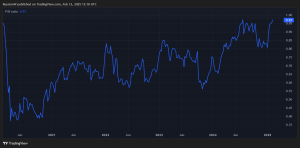The easyJet (LSE: EZJ) share price hit a 52-week high of 591p in April, but then slumped to 428p at close on 23 July.
Yet as I write on Wednesday morning (24 July), I’m looking at a 6% rise to 454p, on the back of a Q3 trading update.
CEO Johan Lundgren told us that “we remain on track to deliver another record-breaking summer“. On that alone, the forecast price-to-earnings (P/E) ratio of only 6.5 might make the shares look cheap.
Profits up
The third quarter saw passenger growth of 8% year on year, with headline profit before tax rising by £33m to hit £236m.
Q4 revenue is expected to continue the upwards trend, with about 69% of bookings already sold. That pushes the number of seats sold in the peak summer season ahead of last year by 1.5m.
And it all points to an expected full-year capacity of around 100m seats.
That should be enough to take three-quarters of the UK population on holiday, and bring us all back again.
Holidays boost
The biggest Q3 revenue gains came from easyJet Holidays, with a bumper 42% rise to £336m. It helped take total group revenue to £2.6bn, up 11%.
Revenue is fine, but there are two things about an airline business that can trouble me in tough economic times.
One is fuel, with oil up around $80 per barrel right now. But fuel costs came in at a manageable £625m, up just 7% on Q3 last year. It amounts to only around half the airline’s ex-fuel costs.
But saying that, headline EBITDAR costs reached £2.2bn. And that makes the profit figure of £236m look a fair bit less rosy. The difference between profit and loss can be wafer thin, and I see that as a big risk.
Debt can be another killer, but there’s no problem here. There was £456m net cash on the books at 30 June, up from £146m three months earlier.
Screaming buy?
Does all this point to an unmissable buy for me here?
We need to remember that these figures come just two days after rival Ryanair reported a 46% collapse in Q1 profit. That was below forecasts, and the share price took a dive — it dropped 15% on the day.
Ryanair also told us it expects summer fares to be “materially lower” than last year.
Which of these two sets of results might mark the budget airline trend for the rest of the year? It’s hard to tell. But I wonder if easyJet’s consistently superior customer satisfaction ratings might be helping it command the lion’s share of holidaymakers’ stretched budgets.
Best in class?
Analysts expect the low P/E to get even lower in the next few years as earnings rise.
We’re also looking at a PEG ratio, which compares the P/E to the expected earnings growth rate, of only 0.1 this year, and 0.7 for 2025. Growth stock investors often see 0.7 or less as a buy sign.
On these measures, and these latest figures, I think the easyJet share price could be set for a bull run.
But then I remind myself that, though easyJet might be my favourite in the business, it’s still an airline. And those can be hit by many factors outside their control. I don’t need the risk.
This post was originally published on Motley Fool







